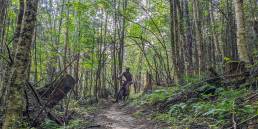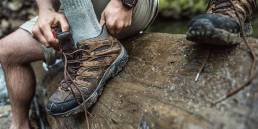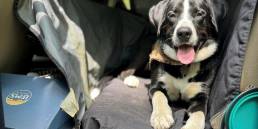“Are you planning to hit that rock for a reason?”
“Tell me where to go; don’t tell me where not to go!”
“You have to speak louder!”
“The glare! I can’t see!”
Dodging rocks on a river takes practice, and learning is trial-by-fire. My friends and I are all hardy hikers and have been on many challenging adventures, but this is our first long-distance canoe trip, paddles in hand. We are all outside of our comfort zone. And as the current moves us swiftly down Maine’s Allagash Wilderness Waterway, we discover we need to do more than just muster some paddling skills.
In the months since we planned this trip, we had all done more reading about canoeing than actual canoeing, and this became apparent soon after we slid our boats into the quiet water of Umsaskis Lake. One canoe began drifting aimlessly, as if unmanned, and another traveled in circles. Paddling requires cooperation, and while we’re a tight-knit team, we’re each used to choosing our own path. Snippets of unhappy conversations between partners swirled, along with the canoes, in the afternoon breeze.
Forming a line of four boats in the middle of the lake, we huddled for a pep talk. We shared stroke advice and discussed fundamentals (steering happens at the back). Things improved moderately after that and more dramatically after we stopped for a snack break on land and rotated some people from the stern to the bow. Still, we made slow progress, and when we reached our first obstacle, a short portage around Long Lake Dam, we decided to call it a day. We were tired and frustrated. Mostly, though, we were concerned about the rapids, the Allagash Falls portage, and everything that lay ahead in the next 50 miles.
We set up camp in relative silence, each contemplating our own inadequacies. But our moods brightened after a refreshing swim and a good meal: vegetables, beans, and sausage cooked in tin foil packets over the fire. River camping was beginning to grow on us. When we crawled into our tents and hammocks, our concerns about what we might encounter downstream faded, blurred by the soothing sound of water rushing over the old dam. Overhead, we were blanketed by a dark sky alive with shooting stars.
In the months since we planned this trip, we had all done more reading about canoeing than actual canoeing, and this became apparent soon after we slid our boats into the quiet water of Umsaskis Lake.
The midsummer sun stretched warm arms down the river as we packed our canoes the next morning. We set off with renewed energy. Bald eagles, great blue herons, kingfishers, and mergansers became our constant companions. We slipped silently by, in awe, as deer crossed the river ahead of us. Paddlers at the stern became more adept at making minor course corrections, and those in the bow improved their forward stroke with their paddles. Beyond technique, there’s an intuitive nature to paddling that we were beginning to understand. And just as we started to feel the rhythm, we entered the first of many rips (easy rapids).
Suddenly we were being propelled quickly forward regardless of our will. Why had we put ourselves in this position? Who’s idea was this? What was the difference between an upstream V and a downstream V? Our limited knowledge of river reading abandoned us in the panic. Initially, we turned on each other.
We yelled frantically over the din of the current and bounced off more than a few rocks, our paddles aimlessly grabbing at water, but eventually exited the rips unscathed. Floating in the calm water, flanked by towering eastern pine, spruce, and fir, we gathered our thoughts. We weren’t in danger of being thrown into a frothy torrent. The water level was perfect for beginners. It wasn’t fear we were feeling. It was something else.

As avid, goal-oriented adventurers, we like to be in control. This trait has served us well on previous expeditions that have depended on our calculated, careful steps, our detailed risk analysis, and if needed, our wilderness medical training. But this trip required something more of us. It required surrender.
It didn’t come easily, but the river was a generous teacher. We resisted a little less each time, and finally, when another set of rips appeared, shimmering in the slanted light, we leaned in fully, gave ourselves to the task, and moved with the current. And as we careened down the turbulent waterway, something deep within our souls stirred. We were one with this wild, beautiful place. Soon we were screaming with delight rather than desperation.
That evening, as a few of us skinny-dipped after another delicious meal, we were no longer burdened with thoughts of rapids or portages. But it was more than that. Our everyday worries, the heavy loads we had become alarmingly accustomed to, had been inexplicably lifted, taken with the swift current. The lightness was visceral.
As avid, goal-oriented adventurers, we like to be in control. This trait has served us well on previous expeditions that have depended on our calculated, careful steps, our detailed risk analysis, and if needed, our wilderness medical training. But this trip required something more of us. It required surrender.
The portage for Allagash Falls came early the following day. We changed into trail runners, hoisted heavy loads on our backs and shoulders, and traveled by foot to the other side of the falls. After flowing with the river, this mode of transportation felt woefully inefficient. Still, many hands made (relatively) light work, and we portaged it all in just two trips. We rewarded ourselves with a long swim below the falls before pushing off again.
The remaining miles went too quickly. As we meandered through this remote wilderness waterway, it alternated between dead water, slow current, and easy rapids. We learned to embrace each change, and each one made us feel more connected, more grounded, more free. As we pulled our canoes onto the shore in Allagash Village, we did so with renewed resiliency. With sculpted arms, the warm flush of accomplishment, and the lightness of unburdened hearts, we started planning our next paddling trip.

Sarah Hunter
Sarah is the communications director for Pine Island Camp, a trip leader for the Appalachian Mountain Club, and a freelance writer. She lives in Maine with her husband and their two sons, and together have trekked and pedaled thousands of miles – from day hikes and backpacking trips in the high peaks of New England to week-long, self-supported bike tours in the US and Canada.
Related Posts
April 24, 2024
What to Bring When Road Tripping with Your Dog
Prepare for the ultimate road trip with…




